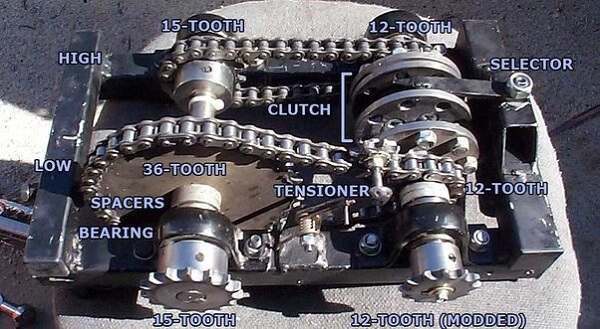Go-Kart Transmissions Everything You Need To Know About
 For Go-Kart lovers, these vehicles are exciting to drive. But, have you known about one of the most critical components in a Go-Kart that empowers it? The answer lies in the Go-Kart transmissions, a device closely connected to the crankshaft.
In this article, we will learn everything about Go-Kart transmission, including its types, uses, and situations they will be the best at. Let's go!
For Go-Kart lovers, these vehicles are exciting to drive. But, have you known about one of the most critical components in a Go-Kart that empowers it? The answer lies in the Go-Kart transmissions, a device closely connected to the crankshaft.
In this article, we will learn everything about Go-Kart transmission, including its types, uses, and situations they will be the best at. Let's go!
- How Do Go Karts Work?
- How To Build A Go Kart With The Lowest Budget
- What Is A Live Axle And How Does It Work On A Go-kart?
- Get The Inside How Go Kart Torque Converters Work!
What Are Go-Kart Transmissions?
 A Go-kart transmission is a device that uses the rotational force created by the rear axle's engine and two wheels to accelerate the kart.
The three most popular types are direct drives (no transmission), automatic transmissions (torque converter and clutch), and manual transmissions (gearbox).
The transmission will be decided based on what type of the go-kart is and how the operation will go. An easy example is the automatic transmission system is more frequently seen on homemade and off-road karts. At the same time, manufacturers often install a gearbox (manual transmission) for go-karts made for racing.
Each transmission type will have a different characteristic that makes it usable for such kinds of carts only. We will have a deep investigation of each transmission type for you to figure out fully.
A Go-kart transmission is a device that uses the rotational force created by the rear axle's engine and two wheels to accelerate the kart.
The three most popular types are direct drives (no transmission), automatic transmissions (torque converter and clutch), and manual transmissions (gearbox).
The transmission will be decided based on what type of the go-kart is and how the operation will go. An easy example is the automatic transmission system is more frequently seen on homemade and off-road karts. At the same time, manufacturers often install a gearbox (manual transmission) for go-karts made for racing.
Each transmission type will have a different characteristic that makes it usable for such kinds of carts only. We will have a deep investigation of each transmission type for you to figure out fully.
What Are The Types Of Go-Karts Transmission?

No Transmission
Don't be mistaken that having no transmission is a type of transmission in go-karts. It is a configuration of uncommon settings in specific situations, but there are settings from small, homemade, or electric go-karts. These karts running with no transmission at all are called direct drive.Automatic Transmissions
A torque converter or a clutch can be classified as an automatic go-kart transmission. These settings can adjust the machine to engage or disengage when the crankshaft has exceeded a certain speed, in which the units are RPM. Due to the settings' characteristics, the automatic transmission can make go-karts travel idle once an engine empowers it (the RPM exceeds a specific speed) or non-empower it (the RPM falls under a specific speed).Manual Transmissions
If gearboxes run your karts, the kart is run by the manual transmission. The boxes help drivers commit to a specific gear using a knob, which means more control over the gear ratio when traveling.An Insightful Research Of Go-Kart Transmission

Direct Drive
It is called direct-drive go-karts whenever you see a go-kart with no transmission at all. These vehicles transfer the rational force directly from the engine to the rear axle using a sprocket and a roller chain. So, for these engines, the go-karts powered by gas cannot modify the power transfer according to the wheels, which means no constant engagement. Unless the engine of direct drive go-karts has the idling settings, the car itself will not have that. When you turn on the engine, the go-kart can start moving. The go-kart's speed can be modified using the accelerator and brake pedal; however, it does not work the same for gear ratio. This number remains constant and is not modifiable compared to a torque converter. Another alternative for no-transmission go-karts is electric go-karts. These vehicles have become more common than ever, and they don't need clutch or torque converters. Instead, they use the speed controllers and a direct drive configuration for running. On the other hand, you can hardly find a gas-powered go-kart with direct drive settings since getting a transmission for such entertaining-source karts is cheap and handy. But racers need more equipment to make their vehicle ready for fire! They need a centrifugal racing clutch, or a gearbox in manual mode, for their vehicles to be approved by CIK-FIA.Go-Kart Clutch
A go-kart clutch works based on a fixed-gear ratio, which is called a non-variable automatic transmission. A clutch, which resides at the crankshaft, is responsible for delivering rotational force from the engine to the rear axle. You can find many types of clutches available for your go-karts. Although they vary from design and mechanism to power, they all want to achieve the same goal of transmitting power to the rear axle. Let's see the most frequently seen go-kart clutches in the market:- Centrifugal
- Belt
- Electric
- Hydraulic
Comments
Post a Comment